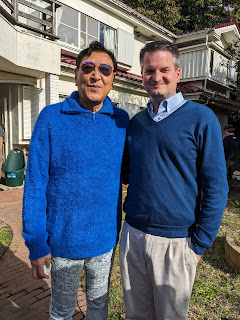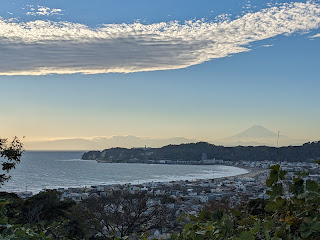 |
| Ryo Tamura. Photo by Brett Homenick. |
Thursday, November 30, 2023
In the Company of a Showa-Era Actor!
Wednesday, November 29, 2023
Seeing 'Suspiria' in 4K!
 |
| Suspiria (1977) at the Shin Bungeiza. Photo by Brett Homenick. |
 |
| Suspiria merch for sale! Photo by Brett Homenick. |
As for Suspiria, I was kind of tickled how similar the opening of the movie was to Evil of Dracula (1974). Both films open with a taxi ride by our out-of-towner protagonist to a creepy school run by ghouls and goblins (not to be confused with the band Goblin, who provides the score for the flick). In the late '90s, I remember hearing from more than one tokusatsu fan the old yarn about how George Lucas ripped off the story of The Magic Serpent (1966) for Star Wars (1977), so I probably shouldn't give anyone wild ideas here. I mean, some people still believe that RoboCop (1987) was a rip-off of Space Sheriff Gavan (1982-83).
Wow, did I get off-topic. That might be because I don't have much else to say about the film. Interestingly, seeing it in 4K on the big screen didn't change my opinion one iota. It's certainly a much better visual experience, and the film definitely does look amazing in general, so I'll give it credit for that. But I didn't find the story engaging, nor did I find it particularly creepy or remotely scary.
No argument here that maggots are gross, and looking at them is unpleasant, but that doesn't mean showing them in a movie automatically puts you in "master of horror" (whatever that's supposed to mean, anyway) territory. The movie isn't very well acted (which, in fairness, might be more of a problem with the voice actors who dubbed the principals), the scares aren't very scary (the fake blood looks exactly like what it is, and the stabbing in the first death scene seemed surprisingly lethargic), and the climax was a let-down (despite all the build-up, the final boss was sure defeated pretty easily).
I did enjoy the score by Goblin and the visuals, but that was about it. I think it's fair to say that Dario Argento movies just aren't my cup of tea. I do want to see Deep Red again at some point, as I'm sure I'd have a better time with that one. (I still vividly remember the opening scene, which sure is an attention-grabber.)
Tuesday, November 28, 2023
Mizuho Suzuki, 'Godzilla 1985's' Foreign Minister Emori, Passes Away at Age 96
 |
| Mizuho Suzuki. |
Actor Mizuho Suzuki, best known to Godzilla fans for his role as Foreign Minister Emori in Godzilla 1985 (1984), passed away due to heart failure in Tokyo at 11:01 p.m. on November 19. He was 96. A private funeral has already been held.
Aside from his turn in the Godzilla series, Mr. Suzuki's other notable credits include the Daiei period horror film The Snow Woman (1968), Kihachi Okamoto's Battle of Okinawa (1971), Submersion of Japan (1973), The Last Days of Planet Earth (1974), Conflagration (1975), the Toei all-star actioner The Bullet Train (1975), and Deathquake (1980).
He was also responsible for dubbing Charlton Heston in the theatrical version of Solar Crisis (1990). On the small screen, Mr. Suzuki provided the voice for Don Corleone (Marlon Brando) in The Godfather (1972), as well as Darth Vader in the original Star Wars trilogy, for the Nippon TV broadcasts of those films.
Born in Manchuria on October 23, 1927, Mr. Suzuki moved to Japan after the war at the age of 18 with his father, who was a Japanese soldier, and began his acting career in 1952 when, after graduating from college, he reportedly helped establish the Mingei Theatre Company, although the theater troupe's home page does not mention Mr. Suzuki's involvement in its founding. (It should also be noted that this source only asserts that Mr. Suzuki dropped out of Kyoto University and makes no mention of his graduating from another university.)
By 1958, Mr. Suzuki had made the transition from the stage to the big screen, appearing in several movies for Nikkatsu. In the 1970s and '80s, he would appear in numerous tokusatsu productions at Toho, usually playing government officials, which would earn him a measure of international recognition.
In September of this year, I reached out to Gekidan Dora, the theater company Mr. Suzuki helped found in 1972, about interviewing the actor. I never received a reply, but, given his advanced age, I wasn't too surprised. Unfortunately, it turned out that Mr. Suzuki would pass away less than two months later.
Rest in peace, Mr. Suzuki.
Saturday, November 25, 2023
THE TOKYO DOME! Home of Japanese Pro Wrestling History!
 |
| The Tokyo Dome. Photo by Brett Homenick. |
In 1992, I did see the Pay-Per-View entitled WCW Japan Supershow II, which was co-promoted with New Japan Pro-Wrestling, but I remember very little about it. (I mean, it's been more than 30 years.) It also took place at the Tokyo Dome, though WCW announcers and commentators would always refer to it as the Egg Dome, which made it sound pretty silly to my ear. The Tokyo Dome is a much more respectable name, of course. Who wants to say that he just won a championship at something called the Egg Dome?
This, naturally, just scratches the surface of pro wrestling history at the Tokyo Dome, but I just wanted to share some of my personal memories of it.
'Godzilla Minus One' Ballyhoo at Toho Cinemas Hibiya!
 |
| Godzilla at Toho Cinemas Hibiya. Photo by Brett Homenick. |
'Godzilla Minus One' (2023), Take Two
 |
| I didn't see Godzilla Minus One on this screen, but it sure would've been nice! Photo by Brett Homenick. |
So, tonight (Saturday, November 25), I went to Toho Cinemas Hibiya to see the movie again. The screen on which I saw it was one of the smaller ones, so it was hardly an IMAX experience, but it was sufficient for my needs. Anyway, I was more interested in filling in the blanks of the story than experiencing bigger and louder explosions.
So did my opinion of the film change at all?
In a word, no.
In three words, yes and no.
In six words, yes and no. But mostly no.
This time around, I didn't feel the use of Akira Ifukube's music was as bad or out of place as I originally thought. The inclusion of it during the Ginza attack was basically tolerable, but I could see why I felt it didn't work during the climax. It does feel a bit awkward there, as it seems to fly in the face of the downbeat and dour atmosphere of the rest of the movie. I suppose it's supposed to highlight the sense of teamwork and camaraderie among the volunteers who are working together to stop Godzilla, but I still think it creates some tonal issues with the rest of the film.
On the other hand, I found the overall spectacle of the CG was less impressive this time. In a lot of ways, that was to be expected. Most movies simply don't hold up on repeated viewings. Once you know what happens, there's a lot less to hold your attention. That was certainly the case here. Once you knew what was coming, there just wasn't a whole lot else there to keep you engaged.
The characters talk a lot about the war and the hardships they experienced, but we never see it. We hear about loved ones who were killed offscreen, but we know nothing about them. We never see their faces. But it's supposed to add depth to the characters that they've experienced these losses during the war. If you're going to go there, movie, then go there. We need to see that. Lines of dialogue and exposition aren't enough to invest the audience.
We are told how Japan lost everything during the war, but what we are shown is that Japan is quick to get back on its feel, and, by about the halfway point, Ginza looks like a pretty happenin' place. So which is it? If we're being totally honest, the title should really be "Godzilla 0.5" or higher.
On a related note, one of the characters delivers a speech about the importance of humanity, but this was again something I wanted to feel, not hear. We don't see the consequences of Godzilla's attacks in any detail. When a character is killed, it feels more like the deletion of computer-generated pixels rather than the loss of a human life. Ishiro Honda conveyed more about humanity with a single shot of a Geiger counter than that dude with the wacky-scientist haircut possibly could with 200 pages of exposition.
I suppose my biggest takeaway from my second viewing was just how boring the climax is. There's no tension to the proceedings, as it's all a foregone conclusion that the whole thing will work on the first try. (I mean, we're way too close to the end credits for the characters to start kicking rocks back to the drawing board.)
The method of defeating Godzilla is also pretty underwhelming. I don't know why director Takashi Yamazaki insisted on implementing a (relatively speaking) real-world solution to the problem of a living, breathing amusement park ride attacking the city. I mean, Godzilla can instantaneously regenerate any damaged body parts and can fire a beam that blows up entire districts in a single go, but it's a bridge too far to create a sci-fi superweapon like the Oxygen Destroyer? Anything beats a droning lecture on Freon gas.
Overall, I still wouldn't say the movie is bad, but I do think it's mediocre. The movie lacks memorable (and even sympathetic) characters. I can't say I was rooting for any of the characters to succeed. At best, I was indifferent to them. At worst, I genuinely didn't like them. If anything, I wanted Godzilla to prevail, but he couldn't even catch that rickety old fishing boat he was chasing for five minutes, so he deserved to get his head blown apart. Serves him right for being so lame.
With all that said, it seems inevitable that this is what's in store for Godzilla's future: Every few years, another "mad genius" director will come out with another Godzilla remake, reboot, or regurgitation, and American fans will ChatGPT out a bunch of hyper-enthusiastic essays, comparing it to Godzilla (1954) sight unseen. I'd rather vote for Kayoco Anne Patterson for president.
Thursday, November 23, 2023
Paying Respects to the Actor Behind 'Ultraman's' Ito
 |
| A young mangaka, Akiko Fukushima, and Bin Furuya. Photo by Brett Homenick. |
Yesterday (Thursday, November 23), I was able to join a unique event held in Kamakura, Kanagawa Prefecture, celebrating the life of the actor Masanari Nihei. Billed as a "garden party," this event was actually held at Nihei-san's home where his family still lives. It was an incredible opportunity and one I couldn't pass up.
 |
| Akiko Fukushima with a shikishi board featuring a drawing of her late husband. Photo by Brett Homenick. |
 |
| With Bin Furuya. |
 |
| The view of the Pacific Ocean from a point near the Nihei home. Photo by Brett Homenick. |
 |
| Another view of the Pacific Ocean with Mount Fuji in the distance. Photo by Brett Homenick. |
 |
| Bin Furuya studies a toy of his alter ego. Photo by Brett Homenick. |












































